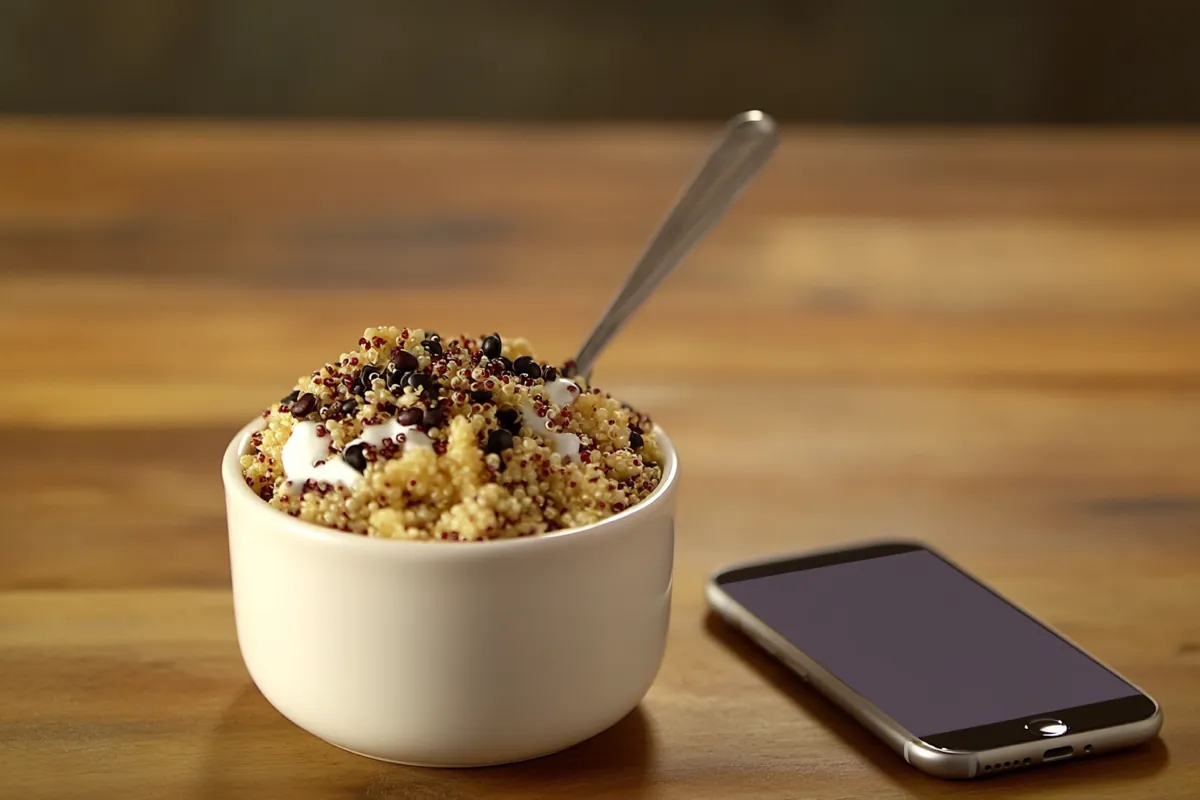Puffed quinoa is becoming increasingly popular in health-conscious circles, and for good reason! This delightful snack packs a punch with its rich nutritional profile and versatility. In this comprehensive guide, we will explore the many puffed quinoa benefits, including its nutritional value, health advantages, and how it compares to other food options like puffed rice.
Table of Contents
Introduction to Puffed Quinoa
Puffed quinoa is a light and airy snack made from the ancient grain quinoa. When heated, quinoa expands and puffs, creating a crunchy texture that is perfect for snacking or incorporating into meals. This method of preparation retains much of quinoa’s original nutritional value, making it a smart addition to your diet.
What is Puffed Quinoa?
Puffed quinoa is created through a process that involves heating raw quinoa seeds until they expand. The result is a crunchy, popcorn-like texture that is both enjoyable and nutritious. Unlike traditional quinoa, which is often cooked or boiled, puffed quinoa can be eaten straight from the package or used in various recipes. You can sprinkle it over salads, mix it into yogurt, or use it as a topping for desserts.
History and Popularity of Quinoa
Quinoa has been cultivated for thousands of years, primarily in the Andean region of South America. Historically, it served as a staple food for indigenous communities due to its high nutritional content. Recently, quinoa gained global attention as a superfood, praised for its protein content and health benefits. This surge in popularity led to the creation of puffed quinoa, making it more accessible and versatile for modern diets.
Puffed Quinoa Nutrition: A Detailed Overview
The nutritional profile of puffed quinoa is impressive. It combines essential nutrients, making it a great choice for health enthusiasts.
Macronutrients in Puffed Quinoa
Puffed quinoa offers a balanced mix of macronutrients, ensuring it can support a variety of dietary needs.
Protein Content and Quality
One of the standout features of puffed quinoa is its protein content. Unlike many plant-based foods, quinoa is a complete protein, meaning it contains all nine essential amino acids. This quality makes it particularly beneficial for vegetarians and vegans. A standard serving of puffed quinoa can provide approximately 4 grams of protein, helping to support muscle repair and growth.
Carbohydrates and Fiber
In addition to protein, puffed quinoa is a good source of carbohydrates. However, it also contains dietary fiber, which is essential for digestive health. A serving typically provides around 2 grams of fiber, promoting a feeling of fullness and aiding in digestion. Including puffed quinoa in your diet can help manage weight and improve overall gut health.
Vitamins and Minerals in Puffed Quinoa
Puffed quinoa is not just about macronutrients; it also contains a plethora of vitamins and minerals.
Essential Vitamins
Puffed quinoa is rich in several vitamins, including B vitamins like folate, which is essential for cell division and overall health. These vitamins contribute to energy metabolism and can help reduce fatigue.
Key Minerals and Their Benefits
Puffed quinoa is also a good source of essential minerals, such as magnesium, iron, and potassium. Magnesium supports muscle function and energy production, while iron is crucial for transporting oxygen in the blood. Potassium helps regulate blood pressure and supports heart health.
Quinoa Benefits and Side Effects
Incorporating quinoa into your diet can have numerous health benefits, but it’s essential to be aware of potential side effects as well.
Health Benefits of Quinoa
Quinoa is often heralded as a superfood, and for good reason! Here are some notable health benefits:
Antioxidant Properties
Quinoa is rich in antioxidants, which can help protect your cells from damage caused by free radicals. These compounds support overall health and may reduce the risk of chronic diseases, including heart disease and cancer.
Heart Health and Cholesterol Management
Eating quinoa can help manage cholesterol levels. Its high fiber content aids in reducing LDL (bad) cholesterol, promoting heart health. Additionally, the magnesium found in quinoa can help relax blood vessels, further supporting cardiovascular health.

Puffed Quinoa Benefits for Weight Loss
Puffed quinoa can be a fantastic ally in your weight loss journey. Its unique properties make it a satisfying and nutritious option for those looking to shed some pounds.
How Puffed Quinoa Supports Weight Loss
Incorporating puffed quinoa into your diet can support weight loss in several key ways.
Low Caloric Density
One of the primary reasons puffed quinoa is beneficial for weight loss is its low caloric density. This means you can consume a satisfying portion without taking in excessive calories. A typical serving of puffed quinoa contains around 100 calories, making it an excellent choice for snacking without guilt. By replacing higher-calorie snacks with puffed quinoa, you can enjoy a fulfilling treat while maintaining a lower overall caloric intake.
High Satiety Value
Puffed quinoa has a high satiety value, meaning it helps you feel full longer. Its combination of protein and fiber can keep hunger at bay, reducing the likelihood of overeating. When you feel satisfied after a meal or snack, it’s easier to stick to your weight loss goals. This makes puffed quinoa a smart addition to meals, snacks, or even breakfast bowls.
Incorporating Puffed Quinoa into Your Diet
Finding ways to include puffed quinoa in your meals can enhance its benefits. Here are some simple ideas:
Quick Snack Ideas
Puffed quinoa can be enjoyed as a quick snack by itself or with added flavors. Try mixing it with a sprinkle of cinnamon and a drizzle of honey for a sweet treat. Alternatively, toss it in a salad for an extra crunch or use it as a topping on yogurt to enhance the texture.
Recipes Featuring Puffed Quinoa
There are many delicious recipes that incorporate puffed quinoa. For example, you can create energy bars by combining puffed quinoa with nut butter and dried fruits. These bars are perfect for a nutritious on-the-go snack. Another option is to include puffed quinoa in your breakfast bowl, mixing it with fruits, nuts, and a splash of milk or yogurt.
Puffed Quinoa vs Puffed Rice: A Nutritional Comparison
When considering puffed snacks, it’s essential to understand how puffed quinoa stacks up against puffed rice.
Nutritional Differences
Puffed quinoa and puffed rice may look similar, but their nutritional profiles differ significantly.
Protein and Fiber Comparison
Puffed quinoa stands out due to its higher protein content compared to puffed rice. While puffed rice offers about 1 gram of protein per serving, puffed quinoa provides around 4 grams. This makes quinoa a better choice for those seeking to increase their protein intake. Additionally, quinoa contains more fiber, which contributes to better digestion and a feeling of fullness.
Glycemic Index and Health Implications
Another critical difference is the glycemic index (GI). Puffed quinoa has a lower GI than puffed rice, which means it affects blood sugar levels less dramatically. This can be beneficial for individuals managing diabetes or those seeking to stabilize their energy levels throughout the day.
Taste and Texture: Puffed Quinoa vs Puffed Rice
Though both puffed quinoa and puffed rice are light and airy, their taste and texture set them apart. Puffed quinoa has a slightly nuttier flavor, while puffed rice is more neutral and crisp. This difference can influence your choice depending on the type of dish you’re preparing. For instance, puffed quinoa can add a richer taste to salads and baked goods, whereas puffed rice works well in sweet recipes and as a base for snacks.
In summary, while both puffed quinoa and puffed rice have their merits, puffed quinoa offers superior nutritional benefits. It’s a protein-packed option that can contribute positively to a balanced diet.

Is Puffed Quinoa Still Healthy?
As puffed quinoa gains popularity, many wonder about its health benefits and nutritional integrity. It’s essential to understand how puffed quinoa fits into a healthy diet.
Nutritional Integrity of Puffed Quinoa
Puffed quinoa retains most of the nutrients found in its raw state. The puffing process does not significantly diminish its protein content or essential vitamins and minerals. This means you can enjoy puffed quinoa while still reaping many of the benefits associated with traditional quinoa.
Moreover, puffed quinoa remains a whole food option, making it a great alternative to processed snacks. Its natural composition contributes to a balanced diet, helping you meet your nutritional goals without sacrificing flavor.
Health Risks and Considerations
While puffed quinoa is generally healthy, some considerations are worth noting. Individuals with specific allergies should ensure they are not sensitive to quinoa, as allergies can occur, although they are relatively rare. Additionally, quinoa contains saponins, a natural coating that can give it a bitter taste. Although most puffed quinoa products are processed to remove these saponins, checking product labels is still a good practice.
If you’re watching your sodium intake, be mindful of flavored puffed quinoa options, as they may contain added salt. Opting for unsalted varieties can help you maintain a balanced diet.
Can You Eat Quinoa Every Day?
Many people wonder if it’s safe to consume quinoa daily. The answer largely depends on individual dietary needs and preferences.
Daily Consumption and Its Effects
Eating quinoa every day can be beneficial due to its nutrient density. The protein, fiber, vitamins, and minerals found in quinoa can contribute positively to your overall health. In fact, including a variety of whole grains in your diet can enhance nutrient intake and promote digestive health.
However, moderation is key. Over-relying on any single food can lead to an imbalanced diet. Therefore, it’s essential to pair quinoa with other foods to ensure you’re getting a wide range of nutrients.
Balancing Quinoa with Other Foods
To maximize the benefits of quinoa, consider incorporating it into a balanced diet that includes a variety of fruits, vegetables, lean proteins, and healthy fats. For instance, you can pair puffed quinoa with fresh fruits in a breakfast bowl or mix it into salads for added crunch and nutrition. This way, you ensure that your meals are diverse and nutrient-rich.
Quinoa Health Benefits and Side Effects
While quinoa is celebrated for its many health benefits, understanding potential side effects is equally important.
Potential Side Effects of Quinoa
Although quinoa is safe for most people, some may experience digestive discomfort. This could be due to its high fiber content, especially for those not accustomed to a fiber-rich diet. Gradually introducing quinoa into your meals can help your body adjust.
Allergies and Intolerances
As mentioned earlier, quinoa allergies are rare but can occur. Symptoms may include skin rashes, gastrointestinal distress, or breathing difficulties. If you suspect an allergy, consult a healthcare professional before consuming quinoa.
Interaction with Certain Medications
Quinoa is generally safe for most individuals, but it may interact with certain medications, particularly those affecting blood sugar levels. If you’re on medication for diabetes or other health conditions, it’s wise to discuss dietary changes with your doctor.
Conclusion on Quinoa’s Health Impact
In conclusion, quinoa is a powerhouse of nutrition, offering numerous health benefits. It can be a valuable addition to your diet, whether consumed daily or occasionally. However, like any food, it’s essential to enjoy it as part of a balanced diet. By being mindful of portion sizes and incorporating a variety of foods, you can enjoy the many puffed quinoa benefits while supporting your overall health.

Final Thoughts on Puffed Quinoa Benefits
Puffed quinoa is a versatile and nutritious food that offers numerous health benefits. From its impressive nutritional profile to its role in supporting weight loss, it can be a valuable addition to your diet. Whether you enjoy it as a snack, in salads, or incorporated into recipes, puffed quinoa can enhance your meals and promote overall well-being.
Summary of Key Benefits
To summarize, here are the key benefits of puffed quinoa:
- High in protein and fiber, supporting muscle health and digestion.
- Low in calories, making it a great snack for weight loss.
- Packed with vitamins and minerals, contributing to overall health.
- Versatile for various recipes and meal options.
Encouraging Incorporation in Diet
If you haven’t tried puffed quinoa yet, now is the perfect time to incorporate it into your meals. Experiment with different recipes and snack ideas to discover how this superfood can enhance your diet. By making simple changes, you can enjoy the myriad puffed quinoa benefits while nourishing your body.
FAQ
As you explore the many benefits of puffed quinoa, you may have some questions. Here are answers to some of the most frequently asked questions about puffed quinoa and quinoa in general.
Is Puffed Quinoa Still Healthy?
Yes, puffed quinoa is still a healthy option! It retains most of the nutritional benefits of raw quinoa, including protein, fiber, and essential vitamins and minerals. Just be sure to choose unsalted varieties to keep your sodium intake in check.
What is the Difference Between Quinoa and Puffed Quinoa?
The primary difference lies in their preparation. Quinoa is typically cooked and served as a grain, while puffed quinoa is created by heating quinoa until it expands and becomes crunchy. Puffed quinoa is often used as a snack or topping, while cooked quinoa serves as a side dish or main ingredient.
Is It Okay to Eat Quinoa Every Day?
Yes, it is generally safe to eat quinoa every day, as long as you maintain a balanced diet. Quinoa is rich in nutrients and can contribute positively to your health. However, it’s essential to diversify your meals by incorporating other grains, fruits, and vegetables to ensure a well-rounded diet.
Is Quinoa Healthier Than Rice?
Quinoa is often considered healthier than white rice due to its higher protein and fiber content. Additionally, quinoa contains more vitamins and minerals, making it a nutrient-dense option. However, brown rice is also a healthy choice, as it retains more nutrients than white rice. Ultimately, the choice depends on personal preference and dietary needs.




